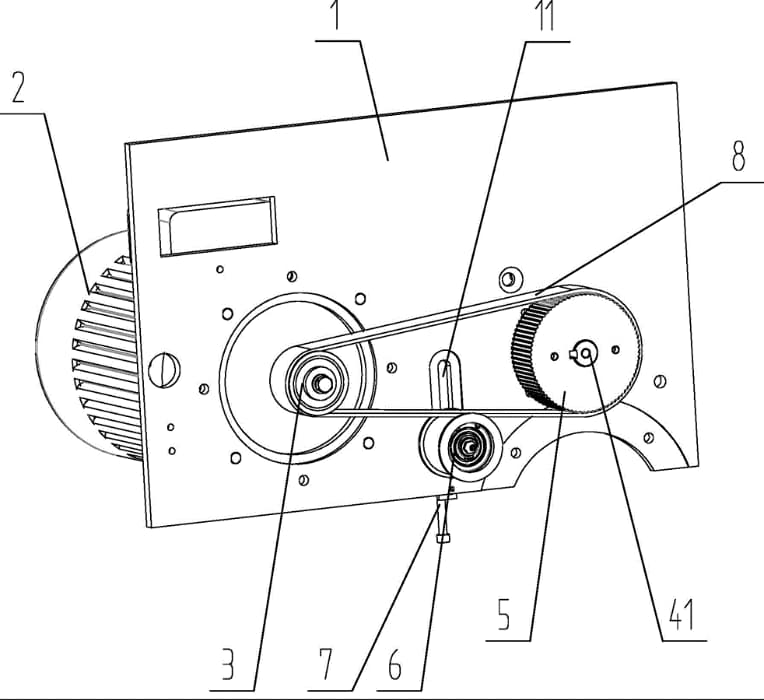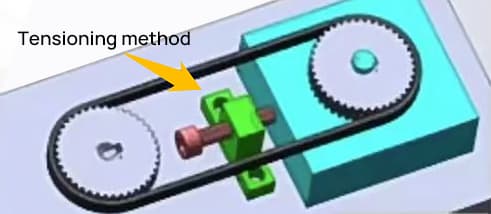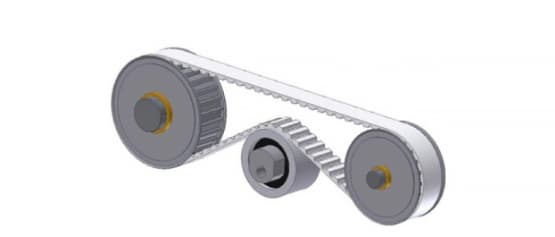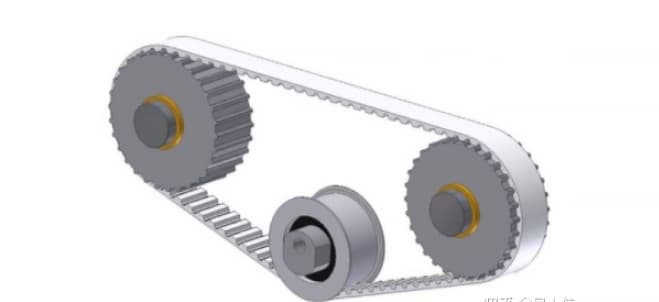Synchronous Belt Principle
A synchronous belt is a flexible circular belt with teeth, and the synchronous belt pulley is machined with grooves that match the tooth profile of the synchronous belt. The force is transmitted by the engagement of teeth and grooves.
There is no relative slip between the synchronous belt and the synchronous pulley, ensuring synchronization between two synchronous pulleys.
In mechanical engineering, synchronous belt transmission mainly has the following movement modes:
(1) Continuous transmission
(2) Intermittent transmission
(3) Alternative transmission
The tensioning method is generally designed into structures that use synchronous belts. This article presents three common forms of tensioning.

Synchronous Belt Features:
(1) Precise transmission, no slipping during operation, with constant gear ratio
(2) Smooth transmission, with damping and vibration reduction capabilities and low noise
(3) High transmission efficiency
(4) Easy maintenance, no lubrication required, low maintenance cost
(5) Wide speed range, with a large power range from a few watts to several hundred kilowatts
(6) Can be used for long-distance transmission with a center distance of up to 10 meters
Advantages of synchronous belt:
◆ Excellent low noise performance (the overall noise level of chain drive is 2-5dB higher than that of belt drive)
◆ Excellent traction and damping performance ensure transmission synchronization
◆ Simple tensioning system construction
◆ The same belt can also drive other accessory pulleys.
1. Parallel Tensioning Method: Preferred Option.

Characteristics:
The preferred method is to rely solely on tension between two synchronous belts to achieve tensioning, as it does not require an external tensioning structure and the tensioning structure itself is very compact.
The advantages of this approach are that it eliminates the need for additional mechanisms, saves material and assembly costs, and reduces the failure rate.
The fewer moving parts in a mechanical system, the more stable it tends to be.
2. External Tensioning Method: Last Resort.

Characteristics:
External tensioning is highly not recommended except in necessary situations:
It is only suitable for low-speed and low-acceleration working conditions;
It is prone to wear problems, surface flatness and spray problems, which are not the main focus of manufacturers' control. In theory, rolling friction is used, but in practice a combination of sliding and rolling friction is used, which makes the outer surface of the synchronous belt more susceptible to wavy texture and wear;
Finally, it also increases production and maintenance costs, adds a moving part, and increases the risk of failure. Therefore, it is not suitable for compact working environments.
3. Internal Tensioning Method: Secondary Option

Characteristics:
The internal tension wheel can be an idler or synchronous wheel. However, using an idler wheel has its disadvantages as the surface of the teeth is not smooth and can cause vibration. On the other hand, using a synchronous wheel produces better results, but at a higher cost.
Additionally, the internal tensioning mechanism will cause the synchronous belt to protrude, increasing arm space and making it unsuitable for compact scenarios.
Therefore, when choosing between internal and external tensioning methods, priority should be given to the most professional and practical internal tensioning wheel.

Observation:
- In the design of the mechanism, the use of tension wheels in synchronous belt transmission must be minimized as much as possible, as they may have a certain impact on its useful life.
- It is recommended that the synchronous belt tension wheel be installed on the loose side of the transmission rather than the tight side for best results.
There are four situations where tension wheels need to be installed:
- The center distance cannot be adjusted by moving the driving wheel and driving wheel, or the position is fixed and cannot be adjusted;
- Large center distance causes synchronous belt jumps;
- To change the spatial position of the synchronous belt (such as avoiding certain parts in the transmission path);
- To meet other design requirements.
Function and points of application of tensioning wheels
(1) Function of tension wheels:
Tension wheels have the following functions in synchronous belt drive mechanisms:
① As a belt tensioning method when the position of synchronous pulleys cannot be designed as adjustable;
② Increase the meshing teeth (number of teeth in engagement) between the larger diameter synchronous belt pulley and the synchronous belt in the high-speed transmission;
③ To increase the gear teeth, to tighten the synchronous belt in multi-stage transmission.
(2) Application Points:
① When the tension wheel is arranged inside the synchronous belt, it obviously needs to be a synchronous belt pulley with the same pitch and must be installed on the loose side of the synchronous belt.
② When the tension wheel is arranged outside the synchronous belt, as the outer side of the synchronous belt is generally smooth, the tension wheel does not need teeth. A flat pulley that can rotate freely is sufficient, and its diameter must be greater than the minimum allowable number of teeth of the synchronous belt pulley and must be installed on the loose side of the synchronous belt.

























































